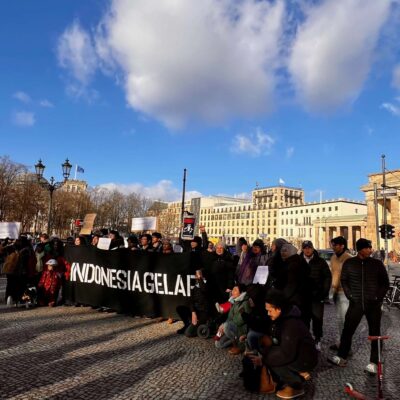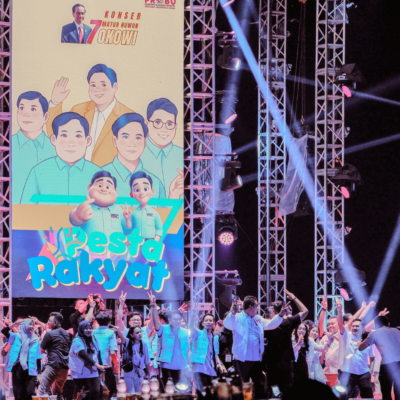The COVID-19 pandemic has caused concern in many nations about potential food shortages due to restrictions on trade and travel disrupting food production and distribution.
In Indonesia, a food shortage is a real concern. The government must ensure food, mainly rice, is available and remains affordable for the majority of the more 250-million Indonesian people; or risk serious social unrest. Early in the pandemic, Indonesia’s President Joko Widodo was placed under pressure when two significant exporters of rice to Indonesia, Vietnam and Thailand, threatened to reduce their rice exports to be sure of meeting their own internal needs (although this has not materialised).
Indonesia is not self-sufficient in rice production. According to recent government data, over the past 20 years Indonesian rice production has been in continuous decline partly due to less land available for rice cultivation. Significant tracts of land formerly used for agriculture have been taken over by housing complexes, roads and airports as urban areas expand. Many farmers have replaced rice with higher income crops, primarily palm oil. As a result, Indonesia relies more than it has in the past on imported rice.
The President has not dealt with the root causes of the decline of rice production. Instead, he has launched a short-term plan to create a food estate in peatland areas, with Central Kalimantan one of his main target provinces. This project means peatlands and locals’ livelihoods are under further threat. In addition, the military’s involvement in the project shows the authoritarian legacy of former President Soeharto’s New Order continues.
The government’s food security plans
The food estate plan in Central Kalimantan for 2020-2021, focuses on 165,000 hectares for rice production. Approximately 85,500 hectares are already rice fields and the remaining 79,500 hectares had been cleared for agricultural purposes, but were abandoned due to poor irrigation systems. So far, the plan does not include new land acquisition and the government says it will collaborate with local people.
The Minister of Public Works and Public Housing (Pekerjaan Umum dan Perumahan Rakyat or PUPR), Basoeki Hadimuljono, says new areas will not be cleared, but existing irrigation systems will be repaired and improved. The Minister says his priority is to be ready for the planting season from October 2020 to March 2021 and the government plans that the total 165,000 hectares will be in full operation by the end of 2021.
The government has also announced another food estate project led by the Ministry of Defence, focusing on cassava cultivation, also to be implemented in 2020-2021. Many details of the project have changed, but as of September 23 the government anticipated the cassava project would include 30,000 hectares of land in Kapuas dan Pulang Pisau districts, also in Central Kalimantan, in 2021. Previously the government has said the project would also involve Gunung Mas and Murung Raya. There are very few publicly available details about the cassava project and it is unclear why cassava has been chosen over other crops; who owns the land; how it will be acquired; whether it will involve clearing forested areas; and exactly how it will be implemented.
The total food estate project will cover 225,000 hectares of land in Central Kalimantan, and will take place within and outside of former President Soeharto’s failed Mega-Rice Project (Proyek Lahan Gambut or MRP).
All Presidents before Jokowi have attempted to establish food estate programs: A rice estate in South Sumatra in the 1970s, Soeharto’s Mega Rice Project in 1995, the Merauke food estate that has been developed since 2010. All failed.
Potential problems with environmental degradation and loss of livelihoods
Activists from the Indonesian Forum for the Environment (WALHI) have expressed concern about Jokowi’s plans, particularly in the peatland areas.
Soeharto’s Mega Rice project, implemented from 1995 to 1997, failed because the Javanese system of rice field cultivation is not suitable for the nutrient-poor and acidic peat soil. Vast irrigation canal systems cut through the peat-swamp causing devastating ecological impacts to peatland ecosystems. Forest clearing and the extensive canal systems dried out the peat, and the canal enabled logging of the forested peat interior. Local people, their customary land tenure and livelihoods were put into jeopardy from the destruction of the surrounding ecosystem.
Since 1997, this degraded area has been prone to frequent huge forest fires that have adversely affected the health of local people as well as causing smoke haze in Singapore and Malaysia. Between 1997 and 2005, peatland forest declined by nine percent per year in Indonesia, and 72 percent of the loss was due to fire.
When I first visited this area in 2009, significant land conflict had occurred between local people who are mix of Dayak, Banjarese, and Javanese transmigrants who settled before and during the MRP. Many of these conflicts involved palm oil corporations—some of whom were illegally established, from the viewpoint of the Ministry of Forestry (now Ministry of Environment and Forestry/MOEF). While these companies had not obtained national approval, they did have permits issued by district governments. Given Indonesia’s decentralised legal framework, MOEF has limited power to terminate their operations. Adding another layer of complexity, it’s currently unclear whether the peatland area will also be under the management of the Peatland Restoration Agency (BRG (Badan Restorasi Gambut).
Compared to Soeharto’s failed MRP project, the current government appears to have tried, at least on paper, to take peatland protection into consideration. The Vice Minister for Environment and Forestry, Alue Dohong (an ethnic Dayak from Central Kalimantan) led the Ministry of Environment and Forestry team’s “rapid” strategic environmental assessment (Kajian Lingkungan Hidup Strategis, KLHS) of the proposed areas, drawing on his position as a former deputy of the Peatland Restoration Agency and long-term involvement in peatland conservation. The KLHS study is required by law and aims to integrate environmental impact assessment in planning and development. The so-called rapid study emphasised the importance of ensuring peatland restoration and recommend livelihood diversification through mixed smallholder farming. However, since MOEF is not the entity leading the food estate project, their role is limited to providing advice.
There will be two different government institutions leading the project. The part focusing on rice production will be led by the Minister of Agriculture, Syahrul Yasin Limpo. In Central Kalimantan, rice production will be in two districts, Kapuas and Pulang Pisau. The rice project, according to Minister Limpo, will not only focus on agricultural production, but also on the post-harvest production process and involve highly skilled labourers and university agriculture graduates.
The Ministry of Defence will lead the cassava food estate and the Defence Minister, Prabowo Subianto, claims he has support from the Governor of Central Kalimantan. The central government intends that cassava will be cultivated for direct consumption, as well as processed into cassava flour for making bread and noodles. It plans to establish 30,000 hectares of cassava in Central Kalimantan in 2021, increasing to 1.4 million hectares by 2025 (although not all of these areas will be in Central Kalimantan).
The re-emergence of military involvement in food security
Jokowi’s preference for using a military instead of civilian leader is not surprising. It is consistent with the central government’s reliance on military personnel to deal with the COVID-19 pandemic. Involving the military in COVID-related projects makes it possible for Jokowi to provide jobs for a high number of generals and colonels, which helps the President build favour within the military, from which he needs help deal with rising Islamic populism.
The appointment of Prabowo is not surprising because some aspects of the military’s dual function (dwi-fungsi) remain from Soeharto’s New Order. The Army’s role in agriculture is part of “Military Operations Other Than War” and consistent with Military Law no 34/2004 that does not limit the role of the army to exclusively military functions.
The involvement of the military in agriculture began during former President Susilo Bambang Yudhoyono’s leadership in 2012, to help with labor shortages and to help train farmers in new technology. Army involvement in agriculture was expanded in 2015, under the then Army Chief of Staff, General Gatot Nurmantyo. Under General Nurmantyo the army not only helped farmers plant crops but also assisted in “…providing counseling to farmers, assisting in the procurement of fertiliser, seeds, and pesticides, building irrigation infrastructure, opening new rice fields, distributing, agricultural machinery, and arranging the selling of the harvest”.
Military involvement is not always in the interests of local villagers. Untrained military officers may contribute to farming failures, such as a case in West Sumatra where the Governor was reported to have instructed farmers to replant the rice fields too soon after harvest. Farmers felt the military could take over cultivation of their land if they refused orders. In another case, it was reported that farmers suffered from crop losses after they were instructed to plant paddies three times instead of two, as specified by local practice. While these examples provide a glimpse into the role of the military in local food production, very few studies have comprehensively evaluated the impact of military engagement in the agricultural sector.
Jokowi has defended his decision on the basis that food security is part of national defence (pertahanan nasional). Some political analysts speculate there was a political deal behind the decision, although Prabowo’s Gerinda party has denied the allegation. The army requested a huge amount of money for their involvement: according to the Vice Minister of Defence, the army requires 68-trillion rupiah over three years for the food project. However, a Kompas report indicates that only 2.1-trillion rupiah will be allocated. There is therefore potential for tension between the ministries of Agriculture and Defence over funding as well as a lack of clarity and coordination with the Ministry of Agricultural and other institutions.
Tempo magazine has reported some tension between the Ministry of Defence and the Army Chief of Staff over control of the project. Defence Minister, Prabowo does not have control over troops and will need army personnel.
Although it seems that the current rice food estate will focus on the unproductive rice fields that had been cleared by transmigrants, the risk of environmental destruction might be higher in the Ministry of Defence-led cassava food estate, which might require clearing forested peatland and affect community land control and ownership. A detailed strategy is needed to ensure that both projects benefit farmers who live in the target areas.
Military engagement in the project might be an example of recent increased military involvement in civilian affairs. This engagement could have a significant influence on the way the concept of the military/civilian relationship will be formulated in the future. Moreover, it is still an open question whether there are other factors behind Jokowi’s decision to assign the Ministry of Defence to the food estate project.
Image: Market, Borneo, Indonesia. Credit: Jorge Franganillo/Flickr.




